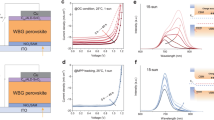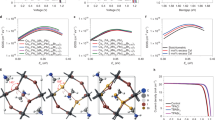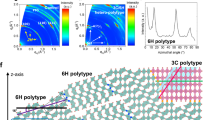Abstract
An issue that affects the scaling-up development of perovskite photovoltaics is the marked efficiency drop when enlarging the device area, caused by the inhomogeneous distribution of defected sites1,2,3. In the narrow band gap formamidinium lead iodide (FAPbI3), the native impurities of PbI2 and δ-FAPbI3 non-perovskite could induce unfavoured non-radiative recombination, as well as inferior charge transport and extraction4,5. Here we develop an impurity-healing interface engineering strategy to address the issue in small-area solar cells and large-scale submodules. With the introduction of a functional cation, 2-(1-cyclohexenyl)ethyl ammonium, two-dimensional perovskite with high mobility is rationally constructed on FAPbI3 to horizontally cover the film surface and to vertically penetrate the grain boundaries of three-dimensional perovskites. This unique configuration not only comprehensively transforms the PbI2 and δ-FAPbI3 impurities into stable two-dimensional perovskite and realizes uniform defect passivation but also provides interconnecting channels for efficient carrier transport. As a result, the FAPbI3-based small-area (0.085 cm2) solar cells achieve a champion efficiency of more than 25.86% with a notably high fill factor of 86.16%. The fabricated submodules with an aperture area of 715.1 cm2 obtain a certified record efficiency of 22.46% with a good fill factor of 81.21%, showcasing the feasibility and effectualness of the impurity-healing interface engineering for scaling-up promotion with well-preserved photovoltaic performance.
This is a preview of subscription content, access via your institution
Access options
Access Nature and 54 other Nature Portfolio journals
Get Nature+, our best-value online-access subscription
$29.99 / 30 days
cancel any time
Subscribe to this journal
Receive 51 print issues and online access
$199.00 per year
only $3.90 per issue
Buy this article
- Purchase on SpringerLink
- Instant access to full article PDF
Prices may be subject to local taxes which are calculated during checkout




Similar content being viewed by others
Data availability
The data that support the findings of this study are available in the paper and Supplementary Information.
References
Li, Z. et al. Scalable fabrication of perovskite solar cells. Nat. Rev. Mater. 3, 18017 (2018).
Bu, T. et al. Lead halide-templated crystallization of methylamine-free perovskite for efficient photovoltaic modules. Science 372, 1327–1332 (2021).
Yang, Y. et al. A thermotropic liquid crystal enables efficient and stable perovskite solar modules. Nat. Energy 9, 316–323 (2024).
Macpherson, S. et al. Local nanoscale phase impurities are degradation sites in halide perovskites. Nature 607, 294–300 (2022).
Bu, T. et al. Modulating crystal growth of formamidinium–caesium perovskites for over 200 cm2 photovoltaic sub-modules. Nat. Energy 7, 528–536 (2022).
Zhang, S. et al. Minimizing buried interfacial defects for efficient inverted perovskite solar cells. Science 380, 404–409 (2023).
Min, H. et al. Perovskite solar cells with atomically coherent interlayers on SnO2 electrodes. Nature 598, 444–450 (2021).
Tan, Q. et al. Inverted perovskite solar cells using dimethylacridine-based dopants. Nature 620, 545–551 (2023).
Park, J. et al. Controlled growth of perovskite layers with volatile alkylammonium chlorides. Nature 616, 724–730 (2023).
Wang, Q., Dong, Q., Li, T., Gruverman, A. & Huang, J. Thin Insulating Tunneling Contacts for Efficient and Water-Resistant Perovskite Solar Cells. Adv. Mater. 28, 6734–6739 (2016).
Peng, J. et al. Interface passivation using ultrathin polymer–fullerene films for high-efficiency perovskite solar cells with negligible hysteresis. Energy Environ. Sci. 10, 1792–1800 (2017).
Bi, D. et al. Polymer-templated nucleation and crystal growth of perovskite films for solar cells with efficiency greater than 21%. Nat. Energy 1, 16142 (2016).
Zhang, H., Pfeifer, L., Zakeeruddin, S. M., Chu, J. & Gratzel, M. Tailoring passivators for highly efficient and stable perovskite solar cells. Nat. Rev. Chem. 7, 632–652 (2023).
Tsai, H. et al. High-efficiency two-dimensional Ruddlesden-Popper perovskite solar cells. Nature 536, 312–316 (2016).
Li, H. et al. 2D/3D heterojunction engineering at the buried interface towards high-performance inverted methylammonium-free perovskite solar cells. Nat. Energy 8, 946–955 (2023).
Luo, L. et al. Stabilization of 3D/2D perovskite heterostructures via inhibition of ion diffusion by cross-linked polymers for solar cells with improved performance. Nat. Energy 8, 294–303 (2023).
Zheng, X. et al. Managing grains and interfaces via ligand anchoring enables 22.3%-efficiency inverted perovskite solar cells. Nat. Energy 5, 131–140 (2020).
Gharibzadeh, S. et al. Record open‐circuit voltage wide‐bandgap perovskite solar cells utilizing 2D/3D perovskite heterostructure. Adv. Energy Mater. 9, 1803699 (2019).
Jiang, Q. et al. Surface passivation of perovskite film for efficient solar cells. Nat. Photon. 13, 460–466 (2019).
Turren-Cruz, S.-H., Hagfeldt, A. & Saliba, M. Methylammonium-free, high-performance, and stable perovskite solar cells on a planar architecture. Science 362, 449–453 (2018).
Yang, W. S. et al. Iodide management in formamidinium-lead-halide-based perovskite layers for efficient solar cells. Science 356, 1376–1379 (2017).
Peng, J. et al. Nanoscale localized contacts for high fill factors in polymer-passivated perovskite solar cells. Science 371, 390–395 (2021).
Fei, C. et al. Lead-chelating hole-transport layers for efficient and stable perovskite minimodules. Science 380, 823–829 (2023).
Liu, C. et al. Tuning structural isomers of phenylenediammonium to afford efficient and stable perovskite solar cells and modules. Nat. Commun. 12, 6394 (2021).
Liu, Z. et al. A holistic approach to interface stabilization for efficient perovskite solar modules with over 2,000-hour operational stability. Nat. Energy 5, 596–604 (2020).
Wang, H., Qin, Z., Miao, Y. & Zhao, Y. Recent progress in large-area perovskite photovoltaic modules. Trans. Tianjin Univ. 28, 323–340 (2022).
Miao, Y. et al. Green solvent enabled scalable processing of perovskite solar cells with high efficiency. Nat. Sustain. 6, 1465–1473 (2023).
Yoo, J. W. et al. Efficient perovskite solar mini-modules fabricated via bar-coating using 2-methoxyethanol-based formamidinium lead tri-iodide precursor solution. Joule 5, 2420–2436 (2021).
Rahil, M. et al. Ruddlesden–Popper 2D perovskites of type (C6H9C2H4NH3)2(CH3NH3)n−1PbnI3n+1 (n = 1–4) for optoelectronic applications. Sci. Rep. 12, 2176 (2022).
Huang, Z. et al. Anion–π interactions suppress phase impurities in FAPbI3 solar cells. Nature 623, 531–537 (2023).
Boeije, Y. et al. Tailoring interlayer charge transfer dynamics in 2D perovskites with electroactive spacer molecules. J. Am. Chem. Soc. 145, 21330–21343 (2023).
Zhang, F. et al. Metastable Dion-Jacobson 2D structure enables efficient and stable perovskite solar cells. Science 375, 71–76 (2022).
Kim, G. et al. Impact of strain relaxation on performance of α-formamidinium lead iodide perovskite solar cells. Science 370, 108–112 (2020).
Guo, J. et al. Ultralong carrier lifetime exceeding 20 µs in lead halide perovskite film enable efficient solar cells. Adv. Mater. 35, 2212126 (2023).
Gao, H. et al. Homogeneous crystallization and buried interface passivation for perovskite tandem solar modules. Science 383, 855–859 (2024).
Luo, C. et al. Engineering the buried interface in perovskite solar cells via lattice-matched electron transport layer. Nat. Photon. 17, 856–864 (2023).
Staub, F. et al. Beyond bulk lifetimes: insights into lead halide perovskite films from time-resolved photoluminescence. Phys. Rev. Appl. 6, 044017 (2016).
Krogmeier, B., Staub, F., Grabowski, D., Rau, U. & Kirchartz, T. Quantitative analysis of the transient photoluminescence of CH3NH3PbI3/PC61BM heterojunctions by numerical simulations. Sustain. Energy Fuels 2, 1027–1034 (2018).
Ding, Y. et al. Single-crystalline TiO2 nanoparticles for stable and efficient perovskite modules. Nat. Nanotechnol. 17, 598–605 (2022).
Li, T. et al. Inorganic wide-bandgap perovskite subcells with dipole bridge for all-perovskite tandems. Nat. Energy 8, 610–620 (2023).
Ma, K. et al. Holistic energy landscape management in 2D/3D heterojunction via molecular engineering for efficient perovskite solar cells. Sci. Adv. 9, eadg0032 (2023).
Tan, S. et al. Stability-limiting heterointerfaces of perovskite photovoltaics. Nature 605, 268–273 (2022).
Li, Z. et al. Organometallic-functionalized interfaces for highly efficient inverted perovskite solar cells. Science 376, 416–420 (2022).
Yang, W. et al. Visualizing interfacial energy offset and defects in efficient 2D/3D heterojunction perovskite solar cells and modules. Adv. Mater. 35, 2302071 (2023).
Metcalf, I. et al. Synergy of 3D and 2D perovskites for durable, efficient solar cells and beyond. Chem. Rev. 123, 9565–9652 (2023).
Zhao, D. et al. Efficient and stable 3D/2D perovskite solar cells through vertical heterostructures with (BA)4AgBiBr8 nanosheets. Adv. Mater. 34, 2204661 (2022).
Mahmud, M. A. et al. Origin of efficiency and stability enhancement in high‐performing mixed dimensional 2D‐3D perovskite solar cells: a review. Adv. Funct. Mater. 32, 2009164 (2021).
Acknowledgements
This work was supported by the National Natural Science Foundation of China (NSFC, grant nos. 22025505, 22220102002, 52203334 and 22209111), the Natural Science Foundation of Shanghai (grant nos. 23ZR1432300 and 23ZR1428000), the Shanghai Pujiang Program (grant no. 22PJ1404700) and the Oceanic Interdisciplinary Program of Shanghai Jiao Tong University (grant no. SL2022ZD105). We thank the Shanghai Synchrotron Radiation Facility for the assistance on GIWAXS measurements. We also thank the Instrumental Analysis Centers of Shanghai Jiao Tong University and the School of Environmental Science and Engineering for assistance with material characterizations.
Author information
Authors and Affiliations
Contributions
Y.Z., C.O. and Y.M. designed and directed the research. H.W., S.S. and Y.C. carried out the fabrication and characterization of PSCs and PSMs. M.R. prepared devices and samples for characterizations and measured XPS/UPS spectra. S.W. assisted with the PL mapping, GIWAXS and HR-STEM measurements. Y.W. and C.Z. participated in SEM, AFM, TRPL and TPC/TPV characterizations and data analysis. Y.Z., C.O., Y.M., Y.C. and H.W. wrote the paper with inputs from all authors.
Corresponding authors
Ethics declarations
Competing interests
The authors declare no competing interests.
Peer review
Peer review information
Nature thanks Mohammad Khaja Nazeeruddin, Feng Yan and the other, anonymous, reviewer(s) for their contribution to the peer review of this work.
Additional information
Publisher’s note Springer Nature remains neutral with regard to jurisdictional claims in published maps and institutional affiliations.
Supplementary information
Supplementary Information
This file contains Supplementary Figs. 1–37, Supplementary Table 1, Supplementary Notes 1–4 and Supplementary References.
Rights and permissions
Springer Nature or its licensor (e.g. a society or other partner) holds exclusive rights to this article under a publishing agreement with the author(s) or other rightsholder(s); author self-archiving of the accepted manuscript version of this article is solely governed by the terms of such publishing agreement and applicable law.
About this article
Cite this article
Wang, H., Su, S., Chen, Y. et al. Impurity-healing interface engineering for efficient perovskite submodules. Nature 634, 1091–1095 (2024). https://doi.org/10.1038/s41586-024-08073-w
Received:
Accepted:
Published:
Issue Date:
DOI: https://doi.org/10.1038/s41586-024-08073-w



